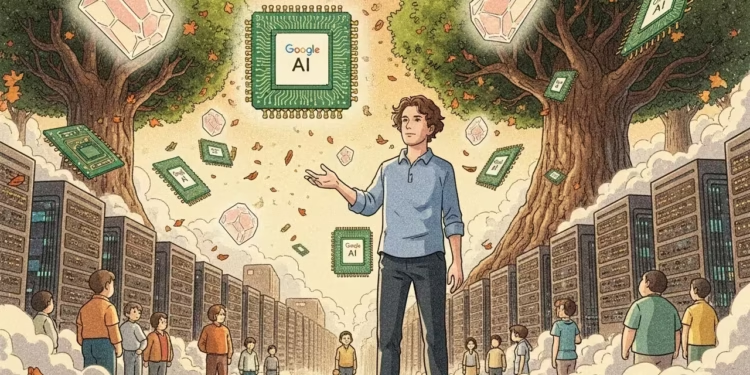BREAKING: June 28, 2025— OpenAI is now using Google’s AI hardware to power ChatGPT and its other offerings. This is the first large step the corporation has taken away from relying just on Nvidia GPUs and Microsoft’s data centers. People close to the acquisition say,
“It’s important to diversify our infrastructure so that our AI models are reliable and can handle stress.”
Strategic Infrastructure Shift Changes the AI Scene
This is the first time that two AI businesses have worked together, and it shows how huge tech companies are changing the way they look about computing infrastructure. In the past, OpenAI was one of Nvidia’s major commercial customers. OpenAI has traditionally used graphics processing units (GPUs) a lot for both training models and inference computing, which is when AI models apply what they’ve learned to make predictions based on new data.
The partnership is based on Google’s Tensor Processing Units (TPUs), which are specialized chips that were only used for Google projects in the past. By making these proprietary processors available to more people outside of the corporation, Google has been able to gain significant clients like:
- Apple
- Anthropic
- Safe Superintelligence (all of which were created by former OpenAI leaders)
Cost Optimization Drive for Multi-Dimensional Strategic Analysis
OpenAI rents TPUs from Google Cloud largely to minimize inference costs. These costs are a key component of running ChatGPT as it grows to service millions of users across the world. TPUs are designed to function best for inference jobs, which might make them less expensive than Nvidia’s general-purpose GPUs.
Adding variety to the supply chain
The move is in line with what other corporations are doing to fulfill the growing demand for computers and avoid issues in the supply chain by dealing with more than one supplier. Because AI workloads need more computing power than ever before, having a variety of infrastructure is now a strategic necessity for keeping operations running smoothly.
The changing nature of working together in a competitive environment
There is direct competition in the generative AI area, but our alliance illustrates that practical infrastructure can win out over market competition. Google’s willingness to lend computer resources to a big rival suggests that AI businesses are becoming more flexible and putting efficiency first.
Issues with integrating technology
Adding additional hardware platforms makes things more challenging from a technical point of view, according to experts in the area. This implies that a lot of software and workflow adjustments need to be done. But it looks like the probable improvements in performance and reductions in costs make these challenges with implementation worth it.
Getting the market power back in balance
This cooperation changes the way AI infrastructure works a little bit. It makes the industry less dependent on Nvidia and other single manufacturers, and it gives Google a stronger presence in the cloud services market.
What this signifies for the market right now
The agreement comes at a time when Google is making its proprietary TPUs available to more people outside of the company. This turns technology that previously only available to Google employees into a cloud service that can compete with others. This contract illustrates that Google was able to recruit significant customers and build its cloud business by using its own AI hardware and cloud platforms.
People are especially interested in Microsoft’s position because OpenAI’s expansion implies it doesn’t have to rely on Azure data centers as much, even if Microsoft has poured a lot of money into the AI business. This development might make other AI businesses consider about employing similar multi-cloud techniques.
Answering Important Questions
Why would companies that compete with each other cooperate together on infrastructure?
When one provider can’t meet all of a company’s infrastructure demands, operational efficiency and cost control generally come before concerns about competition.
What does this signify for Nvidia’s market share?
Nvidia is still the biggest maker of GPUs, but OpenAI’s use of other chips suggests that specialized AI chips are becoming more common.
How crucial is it to be able to cut costs?
TPUs that are tuned for inference jobs could save a lot of money on running costs, which is particularly essential as AI services grow to serve more people.
Will other AI businesses do things this way?
If this arrangement works out, it might set a good example for other AI startups that use more than one cloud and hardware.
Infrastructure changes that will affect the future
This strategic alignment is more than just finding ways to cut costs; it’s a plan for how AI hardware will be used in the future. OpenAI’s multi-cloud strategy, which includes partnerships with Google, Microsoft, CoreWeave, and Oracle’s Stargate project, is an example of a new way of conducting business that focuses on resilience through diversification.
The alliance indicates that the AI revolution needs infrastructure solutions that go beyond the normal vendor relationships. As the requirement for computing power grows at an exponential rate, successful AI companies will likely start adopting more and more advanced hardware portfolios that contain specialized processors from a number of different manufacturers.
The New Competitive Landscape
In the AI industry, this infrastructure war is drawing new lines in the sand. The strength of the supply chain, the ability to use technology, and the ability to keep costs low will all play a role in gaining a competitive edge. OpenAI’s groundbreaking approach could set the standard for how future AI leaders build their computational foundations in a time when infrastructure choices have a direct effect on how quickly new ideas come to market and how well they do.
This development represents a significant shift in AI infrastructure strategy, demonstrating how competitive dynamics in the technology sector continue to evolve as companies prioritize operational efficiency and supply chain resilience.






